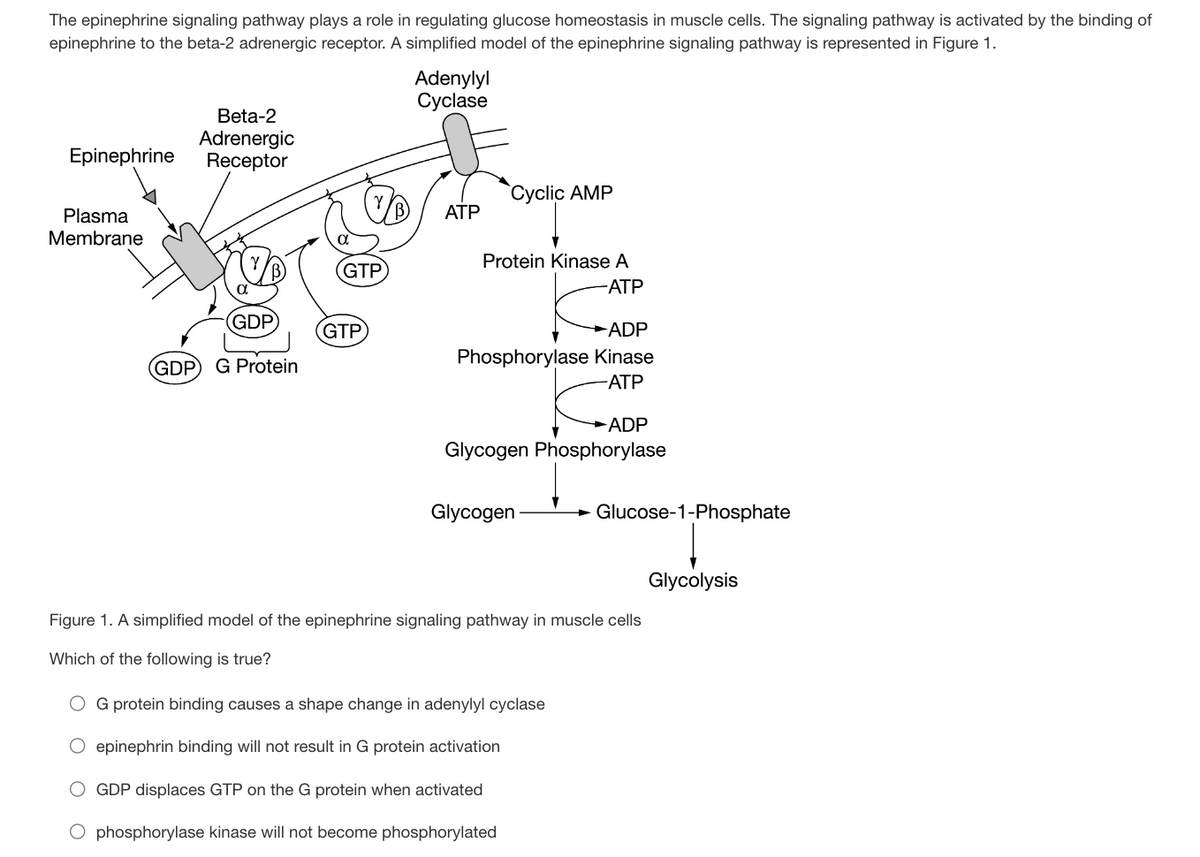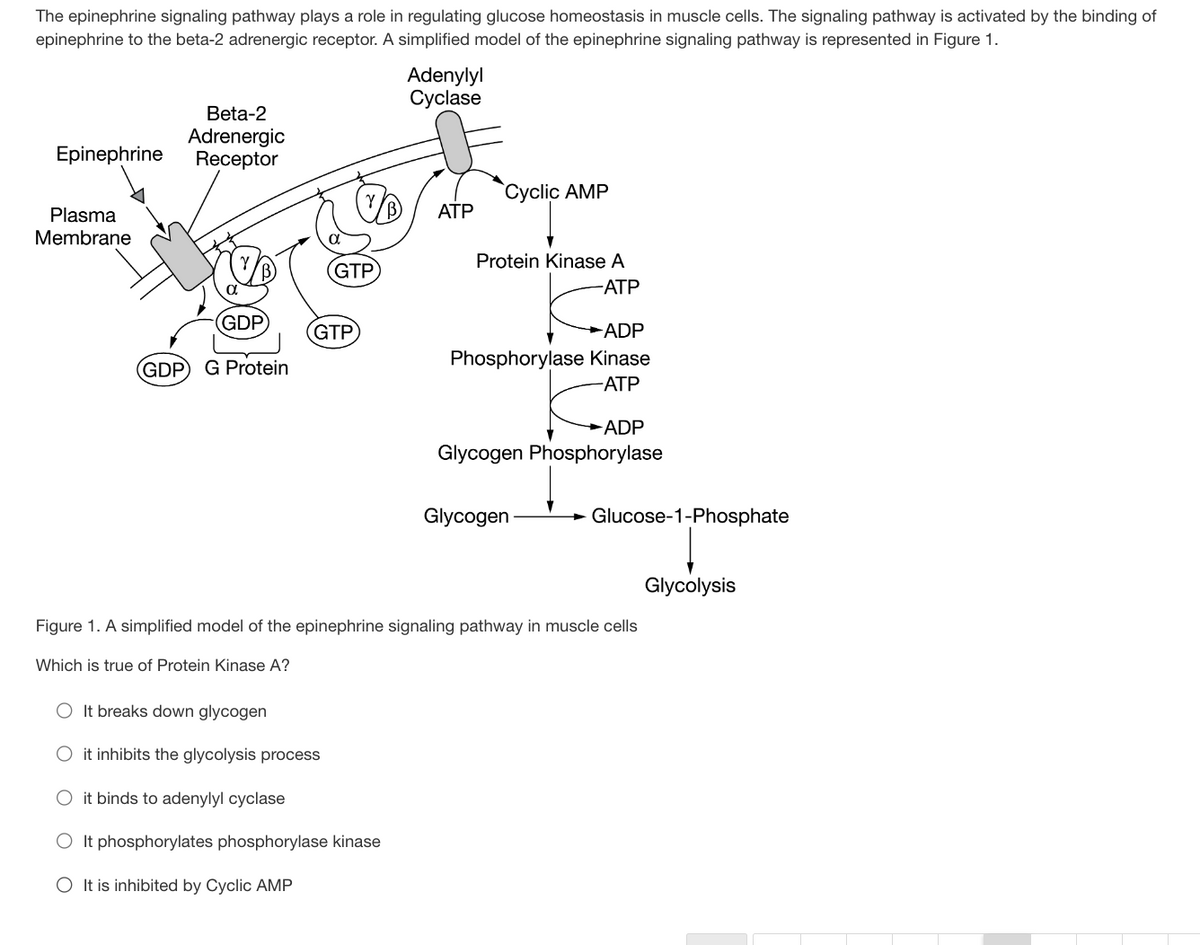The epinephrine signaling pathway plays a role in regulating glucose homeostasis in muscle cells. The signaling pathway is activated by the binding of epinephrine to the beta-2 adrenergic receptor. A simplified model of the epinephrine signaling pathway is represented in Figure 1. Epinephrine Plasma Membrane Beta-2 Adrenergic Receptor GDP GDP G Protein GTP GTP Adenylyl Cyclase ATP Cyclic AMP Protein Kinase A -ATP ADP Phosphorylase Kinase -ATP ADP Glycogen Phosphorylase Glycogen Glucose-1-Phosphate Figure 1. A simplified model of the epinephrine signaling pathway in muscle cells Which of the following is true? O G protein binding causes a shape change in adenylyl cyclase O epinephrin binding will not result in G protein activation O GDP displaces GTP on the G protein when activated O phosphorylase kinase will not become phosphorylated Glycolysis
The epinephrine signaling pathway plays a role in regulating glucose homeostasis in muscle cells. The signaling pathway is activated by the binding of epinephrine to the beta-2 adrenergic receptor. A simplified model of the epinephrine signaling pathway is represented in Figure 1. Epinephrine Plasma Membrane Beta-2 Adrenergic Receptor GDP GDP G Protein GTP GTP Adenylyl Cyclase ATP Cyclic AMP Protein Kinase A -ATP ADP Phosphorylase Kinase -ATP ADP Glycogen Phosphorylase Glycogen Glucose-1-Phosphate Figure 1. A simplified model of the epinephrine signaling pathway in muscle cells Which of the following is true? O G protein binding causes a shape change in adenylyl cyclase O epinephrin binding will not result in G protein activation O GDP displaces GTP on the G protein when activated O phosphorylase kinase will not become phosphorylated Glycolysis
Biology: The Dynamic Science (MindTap Course List)
4th Edition
ISBN:9781305389892
Author:Peter J. Russell, Paul E. Hertz, Beverly McMillan
Publisher:Peter J. Russell, Paul E. Hertz, Beverly McMillan
Chapter9: Cell Communication
Section9.4: Signaling Pathways Triggered By Internal Receptors
Problem 1SB: What distinguishes a steroid receptor from a receptor tyrosine kinase receptor or a...
Related questions
Question

Transcribed Image Text:The epinephrine signaling pathway plays a role in regulating glucose homeostasis in muscle cells. The signaling pathway is activated by the binding of
epinephrine to the beta-2 adrenergic receptor. A simplified model of the epinephrine signaling pathway is represented in Figure 1.
Epinephrine
Plasma
Membrane
Beta-2
Adrenergic
Receptor
GTP
(GDP GTP
(GDP) G Protein
Adenylyl
Cyclase
ATP
Cyclic AMP
Protein Kinase A
-ATP
ADP
Phosphorylase Kinase
-ATP
ADP
Glycogen Phosphorylase
Glycogen
Glucose-1-Phosphate
Figure 1. A simplified model of the epinephrine signaling pathway in muscle cells
Which of the following is true?
G protein binding causes a shape change in adenylyl cyclase
epinephrin binding will not result in G protein activation
GDP displaces GTP on the G protein when activated
O phosphorylase kinase will not become phosphorylated
Glycolysis

Transcribed Image Text:The epinephrine signaling pathway plays a role in regulating glucose homeostasis in muscle cells. The signaling pathway is activated by the binding of
epinephrine to the beta-2 adrenergic receptor. A simplified model of the epinephrine signaling pathway is represented in Figure 1.
Epinephrine
Plasma
Membrane
Beta-2
Adrenergic
Receptor
(GDP
(GDP G Protein
GTP
GTP
Adenylyl
Cyclase
O It breaks down glycogen
O it inhibits the glycolysis process
it binds to adenylyl cyclase
It phosphorylates phosphorylase kinase
It is inhibited by Cyclic AMP
ATP
Cyclic AMP
Protein Kinase A
-ATP
ADP
Phosphorylase Kinase
-ATP
ADP
Glycogen Phosphorylase
Glycogen
Glucose-1-Phosphate
Figure 1. A simplified model of the epinephrine signaling pathway in muscle cells
Which is true of Protein Kinase A?
Glycolysis
Expert Solution
Step 1
*Cell signaling also called as cell communication, is the ability of a cell to receive and process and transmit signals with its environment as well as with itself.
* Signals from outside a cell can be physical agents such as mechanical pressure and voltage and temperature and light and chemical signals
Trending now
This is a popular solution!
Step by step
Solved in 2 steps

Knowledge Booster
Learn more about
Need a deep-dive on the concept behind this application? Look no further. Learn more about this topic, biology and related others by exploring similar questions and additional content below.Recommended textbooks for you

Biology: The Dynamic Science (MindTap Course List)
Biology
ISBN:
9781305389892
Author:
Peter J. Russell, Paul E. Hertz, Beverly McMillan
Publisher:
Cengage Learning

Biology: The Dynamic Science (MindTap Course List)
Biology
ISBN:
9781305389892
Author:
Peter J. Russell, Paul E. Hertz, Beverly McMillan
Publisher:
Cengage Learning